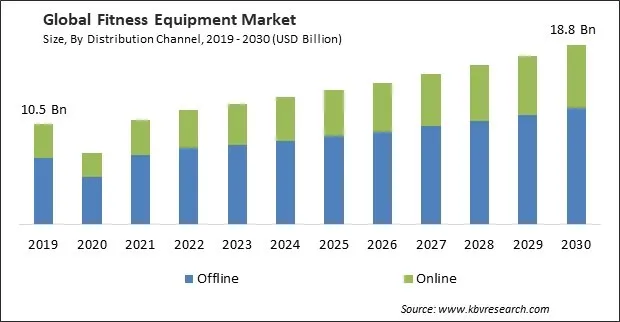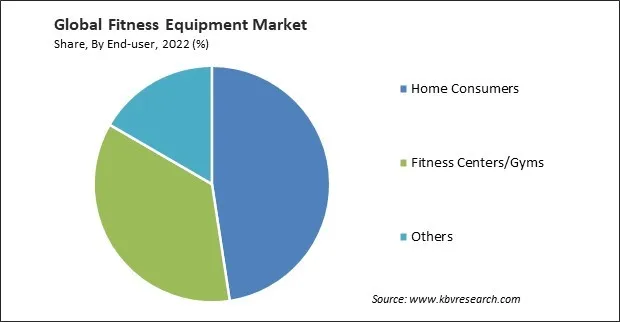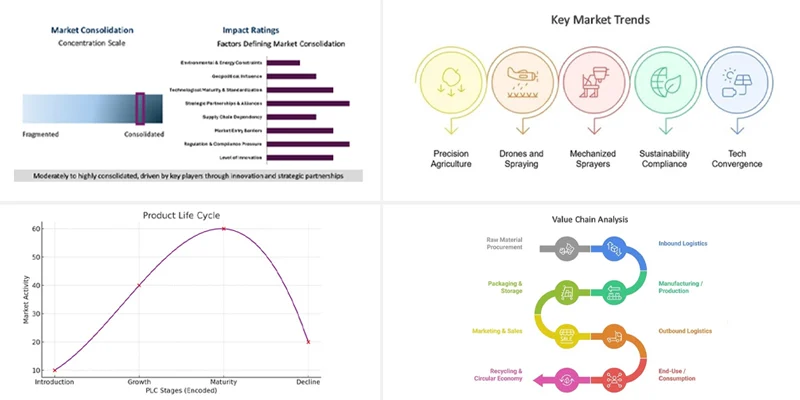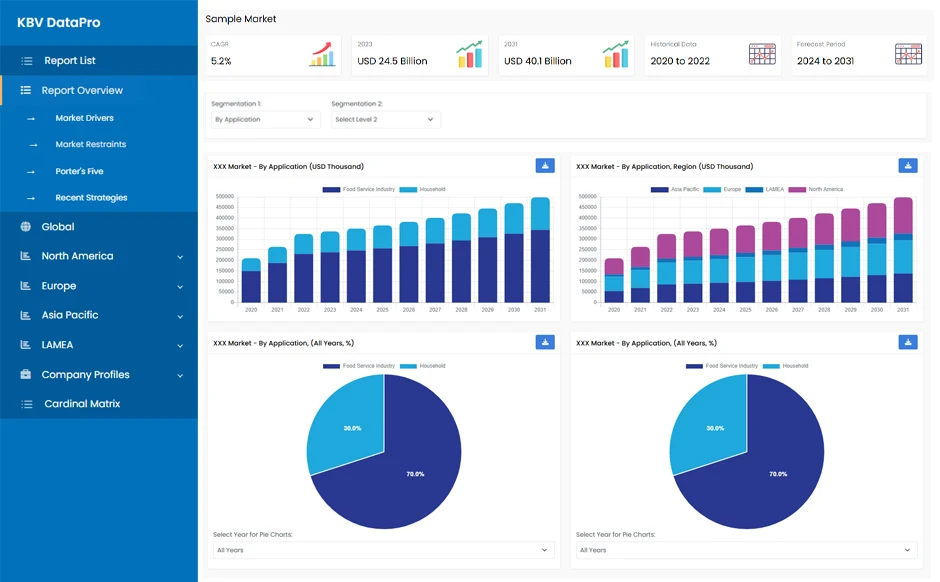The Global Fitness Equipment Market size is expected to reach $18.8 billion by 2030, rising at a market growth of 5.8% CAGR during the forecast period. In the year 2022, the market attained a volume of 8,746.4 thousand units, experiencing a growth of 6.2% (2019-2022).
Treadmill manufacturers have incorporated advanced technology into their products, offering features such as interactive displays, integrated apps for personalized workouts, connectivity options, and live streaming of classes. Thus, the Treadmills segment acquired $3,193.4 million in 2022. These innovations attract consumers seeking engaging and interactive fitness experiences. These aspects will help in the expansion of treadmills segment. Some of the factors impacting the market are increasing health awareness and wellness trends, rise in chronic health conditions, and high cost and affordability of fitness equipment.

There has been a notable cultural shift towards prioritizing health and wellness. Individuals worldwide are becoming more aware of the importance of staying fit and leading a healthier lifestyle. The aspiration for a balanced and wholesome lifestyle has become a driving force behind the increased demand for this equipment. People seek to integrate regular exercise and fitness routines into their daily lives to maintain physical health, mental well-being, and overall vitality. Additionally, Individuals increasingly understand the importance of preventive health measures to avoid chronic conditions. As a response to the growing prevalence of obesity, diabetes, and cardiovascular diseases, many people have become proactive in their approach to health. The demand for this equipment has surged as people seek tools to incorporate regular physical activity, which is crucial in preventing these conditions. Equipment designed for cardiovascular exercise, strength training, and rehabilitation caters to the specific requirements of individuals with chronic health issues. Therefore, these factors will help expand the market.
However, the high cost of advanced fitness equipment can make it unaffordable for many of the consumer base. This can limit accessibility to the quality of this equipment, hindering individuals or fitness facilities from acquiring state-of-the-art machines or tools. The cost barrier can create a segmented market where only certain demographics or individuals with higher disposable incomes can afford premium fitness equipment. This may exclude a significant portion of potential consumers who might otherwise benefit from such equipment. Some consumers, unable to afford new equipment, might turn to the secondary market for used fitness equipment. This can create opportunities for refurbished or second-hand fitness equipment sellers. These aspects will restrain the growth of the market in the future.
The cardiovascular training equipment segment is further segmented into treadmills, stationary cycles, and others. In 2022, the stationary cycles segment garnered a considerable revenue share in the market. The integration of technology into stationary cycles has been a significant driver. Smart stationary cycles with features such as interactive screens, live-streamed classes, and connectivity options to fitness apps have enhanced user experience, making workouts more engaging and interactive. The rise of connected fitness has contributed to the growth of the stationary cycles segment. Users can track performance metrics, join virtual classes, and engage in gamified experiences, creating a more interactive and motivational workout environment. As a result, the segment will grow rapidly in the coming years.
On the basis of end-user, the market is divided into home consumers, fitness centers/gyms, and others. The home consumers segment recorded the maximum revenue share in the market in 2022. The integration of technology in fitness equipment has transformed the home workout experience. Connected fitness solutions, equipped with interactive displays, Wi-Fi connectivity, and access to many online workout programs and apps, have become increasingly popular. This allows users to stream live workouts, access virtual training sessions, track progress, and receive guidance from trainers, replicating the gym experience from the comfort of home. As a result, there will be increased demand in the segment.

Based on distribution channel, the market is segmented into offline and online. In 2022, the offline segment garnered the maximum revenue share in the market. Offline stores often provide expert guidance and consultation, helping consumers choose the right equipment based on their fitness goals, body type, and specific requirements. The guidance from fitness experts or sales representatives can be pivotal in the decision-making process. The offline segment offers immediate availability of products. Customers can walk into a store, select the equipment, and take it home or have it delivered promptly. This immediacy is often preferred by consumers who don't want to wait for shipping or delivery times associated with online purchases. These factors will boost the demand in the segment.
Based on type, the market is segmented into cardiovascular training equipment, strength training equipment, and others. Manufacturers introduced a wide range of equipment designed for various strength training exercises, catering to different fitness levels and preferences. Traditional weight machines, free weights, resistance bands, kettlebells, and bodyweight training equipment have seen innovation and development in terms of ergonomics, versatility, and user-friendly designs. Therefore, the segment will grow rapidly in the upcoming years.
| Report Attribute | Details |
|---|---|
| Market size value in 2022 | USD 12 Billion |
| Market size forecast in 2030 | USD 18.8 Billion |
| Base Year | 2022 |
| Historical Period | 2019 to 2021 |
| Forecast Period | 2023 to 2030 |
| Revenue Growth Rate | CAGR of 5.8% from 2023 to 2030 |
| Number of Pages | 402 |
| Number of Table | 850 |
| Quantitative Data | Volume in Thousand Units, Revenue in USD Billion, and CAGR from 2019 to 2030 |
| Report coverage | Market Trends, Revenue Estimation and Forecast, Segmentation Analysis, Regional and Country Breakdown, Porter’s 5 Forces Analysis, Company Profiling, Companies Strategic Developments, SWOT Analysis, Winning Imperatives |
| Segments covered | Type, Distribution Channel, End-user, Region |
| Country scope |
|
| Companies Included | Suunto Oy (Amer Sports Corporation), Nautilus, Inc., Brunswick Corporation, Johnson Health Tech Co., Ltd., True Image Interactive, Inc., Life Fitness (Cybex International, Inc.), Impulse (Qingdao) Health Tech Ltd. Co., Icon Health & Fitness, Inc. (IHF Holdings Inc.), Torque Fitness LLC., Core Health & Fitness, LLC |
| Growth Drivers |
|
| Restraints |
|
By region, the market is segmented into North America, Europe, Asia Pacific, and LAMEA. The North America segment procured the highest revenue share in the market in 2022. North America has witnessed a significant shift in consumer behavior towards health and wellness. Individuals increasingly prioritize fitness and overall well-being, translating into a higher demand for fitness equipment. The increased awareness of the value of regular exercise and a healthy lifestyle has increased the use of fitness equipment for both personal and business use. These aspects will boost the demand in the segment.
Free Valuable Insights: Global Fitness Equipment Market size to reach USD 18.8 Billion by 2030
The market research report covers the analysis of key stake holders of the market. Key companies profiled in the report include Suunto Oy (Amer Sports Corporation), Nautilus, Inc., Brunswick Corporation, Johnson Health Tech Co., Ltd., True Image Interactive, Inc., Life Fitness (Cybex International, Inc.), Impulse (Qingdao) Health Tech Ltd. Co., Icon Health & Fitness, Inc. (IHF Holdings Inc.), Torque Fitness LLC., Core Health & Fitness, LLC
By Distribution Channel (Volume, Thousand Units, USD Billion, 2019-2030)
By Type (Volume, Thousand Units, USD Billion, 2019-2030)
By End-user (Volume, Thousand Units, USD Billion, 2019-2030)
By Geography (Volume, Thousand Units, USD Billion, 2019-2030)


This Market size is expected to reach $18.8 billion by 2030.
Increasing health awareness and wellness trends are driving the Market in coming years, however, High cost and affordability of fitness equipment restraints the growth of the Market.
Suunto Oy (Amer Sports Corporation), Nautilus, Inc., Brunswick Corporation, Johnson Health Tech Co., Ltd., True Image Interactive, Inc., Life Fitness (Cybex International, Inc.), Impulse (Qingdao) Health Tech Ltd. Co., Icon Health & Fitness, Inc. (IHF Holdings Inc.), Torque Fitness LLC., Core Health & Fitness, LLC
In the year 2022, the market attained a volume of 8,746.4 thousand units, experiencing a growth of 6.2% (2019-2022).
The Cardiovascular Training Equipment segment is leading the Market by Type in 2022; there by, achieving a market value of $9.7 billion by 2030.
The North America region dominated the Market by Region in 2022 and would continue to be a dominant market till 2030; thereby, achieving a market value of $6.3 billion by 2030.
Our team of dedicated experts can provide you with attractive expansion opportunities for your business.

